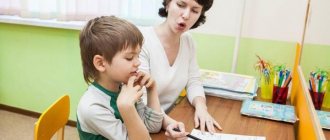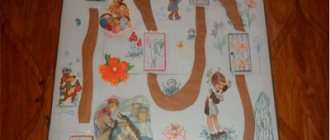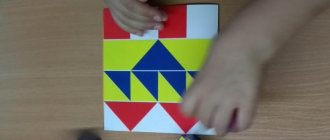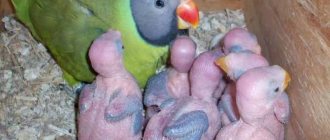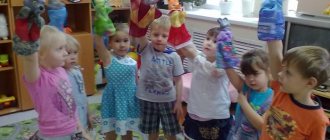September, October, November (1st period of study)
Lexical topics: “Toys”, “Vegetables”, “Autumn”, “Fruits”, “Our body”, “Face”.
Corrective tasks:
a) Formation of vocabulary and grammatical structure of speech:
• develop understanding of speech, the ability to listen attentively to the speech therapist’s speech;
• highlight the names of objects, actions, signs, understand the general meaning of words;
• to form an understanding and practical mastery of the plural form of nouns;
• form the assimilation of certain forms of inflection: endings of singular nouns in the accusative case, agreement of adjectives with masculine and feminine nouns, present tense verbs, endings of masculine and feminine past tense verbs.
b) Development of coherent speech:
• learn to master the skills of composing simple sentences (two words with demonstrative pronouns “this”, “here”, three words with a direct object expressed by a noun in the accusative case), based on questions, demonstrations of actions, based on a picture;
• teach the skills of writing a short descriptive story, retelling, telling a story using a picture using questions and a pre-compiled plan;
• develop dialogical speech skills.
c) Development of cognitive processes:
• ability to distinguish color (red, yellow, green), size (large, small), shape (circle, square, triangle);
• quantitative representations (one - many, two);
• to form visually effective, visually imaginative thinking, memory, attention;
• build awareness of your own body;
• form temporary ideas (autumn).
d) Formation of phonemic perception and sound pronunciation:
• introduce the articulatory apparatus;
• develop auditory attention;
• introduce the sounds “A”, “U”;
• form the prosodic side of speech;
• form the assimilation of the rhythmic structure of speech (memorization of poetry).
Summary of frontal speech therapy classes in the junior group of a preschool educational institution. Animals
Frontal speech therapy session with children of primary preschool age.
Topic “Animals” Author: Marina Alekseevna Durneva, teacher-speech therapist, MBDOU kindergarten No. 17, Kamensk-Shakhtinsky Description: This lesson was conducted with poorly speaking children of 3 years of age. When preparing the lesson, the emphasis was on the lexical topic “Animals”. This lesson will be useful for speech therapists and preschool teachers. Goal: Development of the lexical side of children’s speech (enrichment of children’s vocabulary on the topic “Animals”). Objectives: • develop fine, general and articulatory motor skills;
• cause onomatopoeia in children; • develop the ability to construct simple sentences and answer a question with a sentence; • develop speech hearing, ability to navigate in space and quantitative concepts; • cause the correct pronunciation of the sound [a], form the correct articulatory pattern; • enter the letter “A” as a symbol of the sound [a]; • develop attention, thinking, memory, perseverance, independence. Content
1. Greeting.
- Logori. — Finger game “Friendship” In our group, girls and boys are friends (the fingers of the hands are joined rhythmically in a lock)
You and I will make friends with small fingers
(rhythmic touching of the fingers of the same name on both hands)
One, two, three, four, five
(alternately touching the fingers of the same name, starting with the little fingers),
start counting again.
One two three four five. We've finished counting. (hands down, shake hands)
2. Main part.
— Introducing children into a play situation. Sovunya (a soft toy) arrives, meets the children, and tells the “Tale about the Tongue.” — Articulation gymnastics “Tongue walk.” The tongue woke up and smiled. “Smile”
Opened the window.
“Window”
Looked up, down,
“Swing”
One way, the other.
“Watch”
Closed the window.
Close your mouth
Went to brush your teeth.
I brushed my teeth upstairs and downstairs and went for a walk. “Brushing our teeth”
First, he took a swim in the river.
“Chatterbox”
Then he went to the mosquito to play ball.
“Z-z-z”
Then he helped the beetle wind the threads.
"AND…."
Then I went to the park to ride my horse.
"Horse"
Saw a plane.
I boarded the plane, started the engine, spread my wings and flew away. Hands to the sides, we fly in a circle: “L-l-l”
Landing.
We sat down
and wanted to go home by car.
I looked and the tires were flat. “Sh...”
Let's pump them up.
“Ssss”
Pumped up.
I got into the car and drove home. “I press the pedal and the car rushes into the distance: Dr-rr, dr-rr!” “Start the engine!”
— Game on onomatopoeia “Who talks like that?” 1. Sovunya offers children stencils of animals and individual pictures for them. She asks a riddle: “This beast shouts: “Moo-moo!” - This beast shouts: “Aw-aw!” - This animal screams: “Meow-meow!” - This beast shouts: “Be-be!” Children guess (we call the guess a sentence: “This is a cow (dog, cat, ram)”), find a suitable picture and look for its place in the stencil. After this, the onomatopoeia is repeated. 2. After this, the children’s pictures are collected again. The teacher names the animal, the children must name the onomatopoeia. Whoever says it first wins the card. 3. After playing out all the pictures, the children tell what pictures they have. - Who do you have? - I have a cow...... etc.
— A game for the development of speech hearing, spatial orientation and quantitative concepts “Bring a toy.” The teacher sits down at the table with the children and asks each one in turn to bring several toys (animal figures) from those laid out on another table: “Masha, bring the cat.” The child goes, completes the task and says what he did. - Dynamic pause - Logorhythmics. - Articulatory “imitation” for evoking sounds - Sound “A”. — Children are given a card cut into several parts. You need to put together a picture. What happened? - The teacher shows the whole picture: “I turn into a hippopotamus, I open my mouth very much: “Ah-ah.” Children pronounce the sound "A".
- The teacher shows the children pictures with different situations, and the children voice them (the cat and the baby are happy to meet - ah-ah; the cat burned its paw - ah-ah; the cat ran away with milk - ah-ah). — Finger game “Fingers say hello.” All fingers of the right hand, starting with the index, touch the thumb of the same hand in turn, while simultaneously pronouncing the sound “A” with each contact. — Introduction of the letter “A”. We can denote the sound “A” with the letter “A”. Children are given cards with a letter.
Let's trace the letter "A" with our finger and then with a felt-tip pen. - Logorhythmics - singing the sound “A”. This is a vowel letter and is very easy to sing. Let's sing it. — Letter recognition game “Find the letter.” Children are given different letters, they only need to find the letter “A”. After this, the music is turned on - the children dance; at the end of the music, everyone must take the letter “A” and show it. 3. Conclusion. The results are summed up, the children say goodbye.
We recommend watching:
Notes on speech therapy leisure for the junior group "Pets" Notes on the lesson "Poultry" junior speech therapy group Notes on a joint lesson for children and parents aged 3-4 years. Prevention of speech disorders in children Summary of individual speech therapy classes for children 3-4 years old
Similar articles:
Lesson notes on speech development in the second junior group
December, January, February (2nd period of study)
Lexical topics: “Clothes”, “Shoes”, “Winter”, “New Year”, “Winter fun”, “Winter clothes”, “Wild animals”.
Corrective tasks:
a) Formation of vocabulary and grammatical structure of speech:
• continue to form and consolidate previously studied grammatical categories;
• develop an understanding and practical use of singular forms of nouns in the genitive and accusative cases with prepositions and in the prepositional case;
• to form an understanding and practical mastery of the prepositions U, NA, V, IZ.
b) Development of coherent speech:
• continue to develop and strengthen the skills of writing sentences and simple descriptive stories;
• teach the skills of retelling stories and fairy tales “The Three Bears”, “Kolobok” using questions and a picture plan;
• continue to develop dialogical speech skills in the process of developing communication in preschoolers.
c) Development of cognitive processes:
• color (blue);
• continue the work started in the first period;
• form a serial series “big, smaller, small”, “small, bigger, big”;
• form temporary ideas (winter).
d) Formation of phonemic perception and sound pronunciation:
• continue the work started in the first period;
• introduce the sounds “I”, “O”, “E”;
• learn to perceive by ear and correctly reproduce the simple syllabic structure of words.
Speech therapy exercises for children 2-3 years old
In the second or third year, you can do special speech therapy exercises with your child at home. They develop movements of the lips, tongue and lower jaw. They help strengthen the muscles of the articulatory organs, due to which the appearance of sounds occurs faster. All exercises are performed in front of a mirror.
You can do the following tasks at home:
- bursting of the bubble: the cheeks are inflated as much as possible. Press your palm first on one cheek and then on the other;
- wide smile: lips are drawn out, then you need to smile widely, showing your teeth;
- show your tongue: you need to quickly stick out your tongue and then remove it.
Conducting speech therapy exercises
Speech therapy songs for children 2-3 years old
Speech therapy songs for children 2-3 years old are aimed at automating sounds and clarity of speech. The lyrics and notes of the songs interest children and create a joyful and favorable mood for them. The baby sings along with pleasure, and the activity takes on a cheerful and unobtrusive atmosphere. To conduct classes at home, just download online collections of songs from the Internet.
Open lesson on speech development in the senior group according to the Federal State Educational Standards
Still relevant: Automation of sound J.
The first session of a speech therapist with a child: where to start
Speech therapy classes are carried out for the following purposes:
- Understanding native speech, observing and comprehending everything that happens around. This is how the child learns about the world around him. The speech therapist forms general concepts, gives the basics of word formation, and teaches how to use complex phrases.
- Formation of correct pronunciation of words and development of phonemic hearing. Monitoring the clarity and expressiveness of speech.
- Teaching independent speech using different sentences.
Many people are interested in how the first speech therapist session is conducted. The first session of a speech therapist with a child, where to start:
- The child's disposition towards himself.
- Carrying out diagnostics and identifying problems.
- Introduction to the speech apparatus.
- Teaching simple speech therapy exercises and games.
- Building a work plan.
First session with a speech therapist
Literature to help the speech therapist: Fadeeva Yu. A., Pichugina G. A., “Speech therapy classes in the younger group”
The abstract by Fadeeva and Pichugina is intended for speech therapy classes in the younger group. It promotes the formation of speech skills in children two to three years old who have various speech problems of different etiologies. It is intended for speech therapists, speech pathologists, educators and parents.
Stages of working on a new word in speech therapy
Stages of working on a new word in speech therapy:
- Determining the relationship between a sound word and a visual, auditory and other image.
- Analysis of word composition.
- Identification of semantic features of a word.
- Introduction of a word into the semantic field.
- Consolidating the meaning of a word.
Junior group. Early childhood, nursery. Children 1-4 years old
Summary of the educational activity for modeling “Balls for a clown” in the 2nd group of early age with the participation of a speech therapist
Educator: Filinykh T.V. Goal: to teach children to listen and observe, to develop the ability for dialogical speech, to encourage finger and articulatory gymnastics to take action; consolidate the ability to roll plasticine between your palms and make balls in a circular motion. Materials:…
"Transport". Presentation for a game-based speech therapy session with 2-year-old children Presentation for a game- based speech therapy session with 2-year-old children Lexical topic: “Transport”
.
Goals: - To introduce children to the concepts of “transport”
, with different types of transport. — Improve the ability to navigate in space. — To develop the ability to perform verbal...
